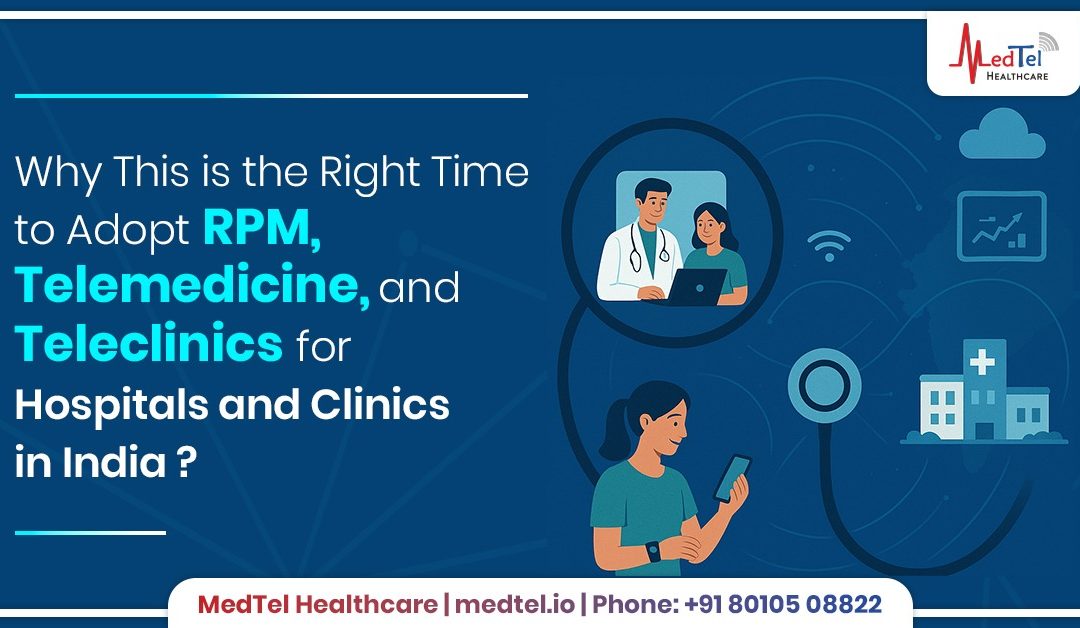India’s healthcare landscape is rapidly evolving. As we continue to face rising patient demands, an overburdened hospital infrastructure, and a growing need for accessibility, especially in rural areas, digital health technologies are no longer optional—they are essential.
Remote Patient Monitoring (RPM), Telemedicine, and Teleclinics are proving to be the most efficient, scalable, and patient-centric solutions.
The question is no longer if healthcare providers should adopt these technologies, but why haven’t they adopted them sooner?
1. Bridging the Urban-Rural Healthcare Divide
Nearly 70% of India’s population lives in rural areas, yet the majority of top-tier healthcare infrastructure is concentrated in urban centers. Teleclinics and remote clinics allow hospitals to set up virtual consultation points in underserved areas, extending their reach dramatically without the need for physical expansion.
With basic internet connectivity and a trained health worker or nurse, virtual outreach clinics can be launched to connect patients with specialists hundreds of kilometers away. This is especially transformative for specialties like cardiology, dermatology, psychiatry, and chronic disease management.
2. Real-Time Care with IoT Medical Devices
The rise of IoT medical devices and Bluetooth-enabled health monitors has made it possible to collect patient vitals remotely. Devices such as digital BP monitors, pulse oximeters, glucometers, and ECG patches can automatically sync with cloud platforms, allowing doctors to monitor patients’ health data in real time—even after they’ve left the hospital.
This Remote Patient Monitoring (RPM) is a game-changer for managing chronic conditions, post-operative care, and elderly patients. With early warning alerts, hospital readmissions can be significantly reduced, and critical interventions can be made proactively before an emergency occurs.
3. Enhanced Patient Connectivity and Engagement
Today’s patients expect more flexibility and convenience. With telemedicine platforms, patients can book virtual appointments, share health records, and consult doctors from the comfort of their homes. This not only improves patient satisfaction but also increases adherence to follow-up care.
By adopting teleclinics, hospitals also have the opportunity to connect with new patients who may not have considered traveling for an in-person consultation. It opens a completely new channel of patient acquisition and retention, essential for growth.
4. Boosting Hospital Efficiency and Revenue
Digital consultations and RPM reduce the burden on outpatient departments (OPDs), freeing up time and resources for more critical cases. Hospitals can expand their reach and serve more patients without increasing their physical footprint. This leads to:
- Higher patient volumes (virtually and efficiently)
- Optimal resource utilization
- New revenue streams through subscription-based RPM or rural outreach programs
Additionally, the data collected through connected devices enables better clinical decision-making and faster diagnosis, potentially reducing the average consultation time.
5. Government Support and Regulatory Clarity
India’s Ministry of Health and Family Welfare has already introduced clear Telemedicine Practice Guidelines, providing a strong legal and ethical framework for remote care. With robust government support for digital health through initiatives like the Ayushman Bharat Digital Mission (ABDM), now is the perfect time for hospitals to align with national healthcare priorities and accelerate adoption.
6. Scalable Models for Every Hospital Size
Whether you’re a 20-bed hospital in a Tier-3 city or a 500-bed multispecialty facility in a metro, the beauty of telemedicine and RPM lies in its inherent scalability. Small clinics can tap into a wider pool of specialists, while large hospitals can optimize their existing doctor base by spreading services to more geographies through virtual clinics.
Final Thoughts: The Time is Now
India stands at the cusp of a healthcare transformation. IoT medical devices, Bluetooth-enabled monitors, telemedicine platforms, and remote clinics are no longer futuristic—they are the foundational tools of today.
For hospitals and clinics, adopting RPM, Telemedicine, and Teleclinics isn’t just about innovation—it’s about maximizing relevance, broadening reach, and building organizational resilience.
Key Benefits of Digital Health Adoption:
✅ Improve patient outcomes
✅ Reach a wider demographic
✅ Reduce operational stress and costs
✅ Attract and retain new patients
✅ Build a future-ready healthcare system
